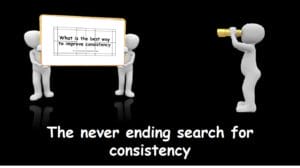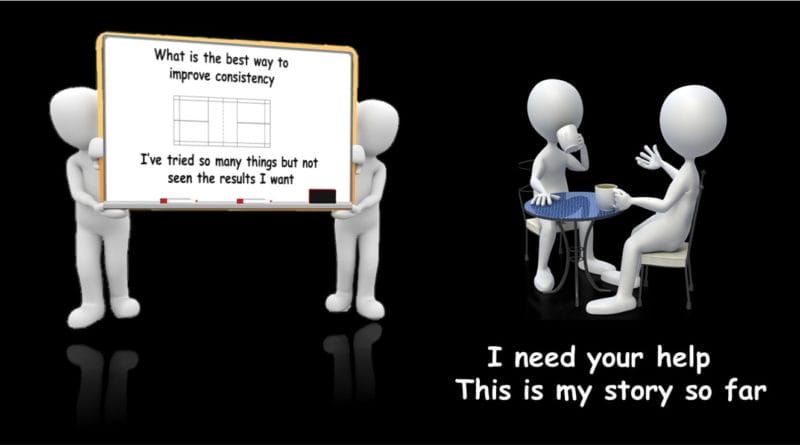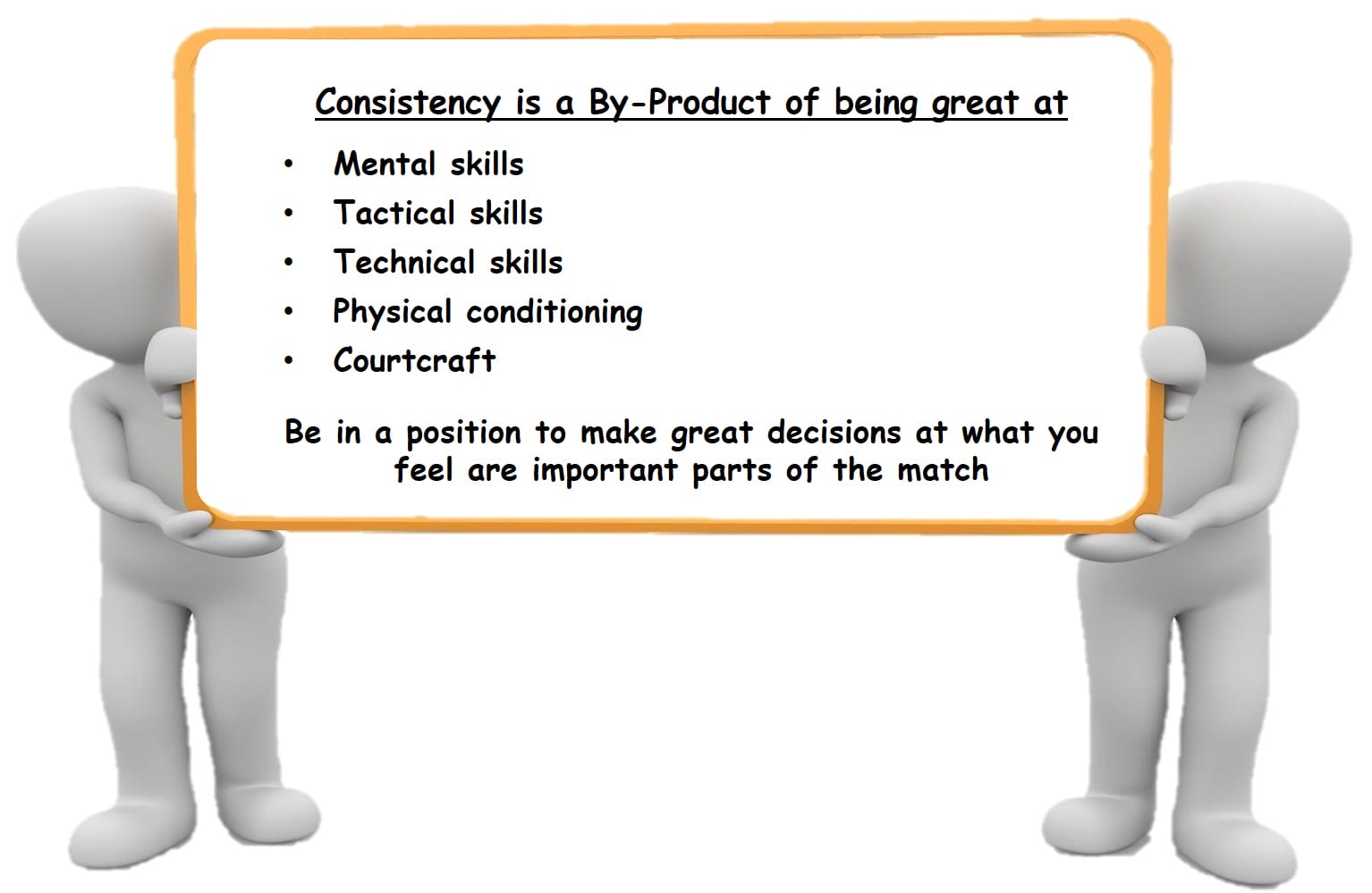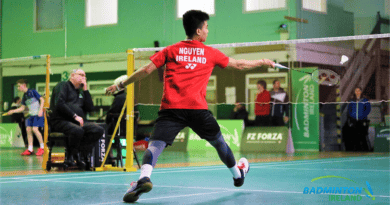The search to improve consistency – my story
How often do you work to improve consistency in your practices?
Do the improvements in practice actually appear in competition?
Here is my story over years of trying to find out what is possible
What is required to become more consistent?
– – – – – – – – – – – – – – – – – –
The important questions
My story
My problem
The things I didn’t understand?
The advice I was given and my response
The conclusion from my journey: the things I’ve learnt
– – – – – – – – – – – – – – – –
Important Questions
Have you asked yourself this question, or have you had advice from other coaches about what to try?
After technique, consistency seems to be the next goal of many coaches and players. It always surprises me that technique and consistency seem to be spoken about more than tactics. and certainly more than mental skills/strategies.
This post is a summary of my thoughts during the first 10 yrs of my coaching journey. I’d been watching matches I’d seen lots of shuttles hit out or in the net with what seemed no pressure on the players. So I thought I’d better start helping my players become more consistent.
My story includes elements from coaches I’ve spoken with and in part is summarised to help with the message. The basis of all the content is my search, especially in the early years, to understand ….
- What was ‘consistency’ and what did it look like
- Could it be measured
- Most importantly, how it could be improved, if at all
Hopefully, when you are reading the words below they will create thoughts and questions. It would be great if you could challenge my viewpoints and express ones of your own.
You may not agree with my arguments or believe that they are too simplistic
I would talk about consistency with my friends but we never really defined what it was,
maybe we didn’t understand all the different aspects or maybe we just ‘blamed’ the players!
– – – – – – – – – – – – – – – –
This post will take you about 5 – 10 minutes to read depending on how often you stop to think or shout at the things I’ve written 🙂
If you want a shorter version click on the image below.
It is part of the series ‘Advice I wish I’d known sooner as a Badminton Coach’

– – – – – – – – – – – – – – – –
My story
What did I see in competition?
Ok, I didn’t expect perfection, my players weren’t that good!
However, the number of high service returns that went into the net or hit off the court was far too high. How could someone just hit a return of serve into the net, they just weren’t consistent enough.
During longer rallies, my players kept the shuttle in court, worked hard to create openings. Then often when one appeared they made a ‘simple’ mistake, again they just weren’t consistent enough.
I started to count the number of errors they and their opponents made and compared them to the number of winners. The ratio often worked out at 3: 1 (errors to winners). Some errors were forced by the opponents’ good shots but many came from simple errors, shots that I thought should have come over.
So, now it was clear, both players just weren’t consistent enough
That’s what I thought… but maybe I could have been wrong?
What did I see in practice?
I knew that my players could play the strokes, I’d seen that in practice. They had hit so many clears, smashes and nets that I knew they could play. We had done routines, multi-shuttle and practice games, all with increasing levels of success and improvement in practice. They knew what was required and their technique was ok, most of the time.
Ok, there were mistakes in the practice but I thought that was normal and anyway the number of mistakes reduced in practice the more shots they hit. We would stop and talk about what to do to reach higher levels of success (shuttles over in a row), or I would shout out in the practice to encourage them to keep going and to give them advice.
I was never sure if they could hear me during the practice or if my encouragement and advice helped, but I felt it did so I shouted loudly to help them. I did all I could to help. In single-shot shuttle practice, I would delay the feed so that as they became tired they could reach the next. During single rally practices (+15 shots) I would hit higher nets or lifts to give them time if I could see that they were struggling!
Ah, but I didn’t count the multi-shuttle shots that went into the net, but they did try hard and get to the end of the sequence without stopping. They certainly became fitter in these ‘physical’ practices. However, they often complained at their being bored or that it was tough to concentrate in the longer sets.
Consistency did improve towards the end of most sessions, the more we hit the higher the percentage over
Was this now going to transfer to competition? I needed to know
How did I measure improvements?
I decided to use practice situations to improve consistency by hitting lots of shuttles and trying to reduce errors. We would do sets of 15-20 shuttles with feeding to just one place.
Sometimes it would be 2 shuttles in the routine but the more we included the less consistent the player became.
I believed that the key to increasing consistency was for the player to get used to hitting lots of shuttles over, often in a row, in what I thought were pressure situations. In the beginning, they would struggle to hit more than say 5-7 shuttles over without a mistake in a drop/net routine. If we tried a shadow/hit routine they would often make errors and it wasn’t always at the end of the 15 shuttle set.
However, I’m sure that as routines progressed in practice they often achieved +90% success in shuttles going over.
The players could see that their shots were improving as they could hit say 15 drops over with no mistakes. They could do a 20 shot drop/net routine and even a 20 x 5 all court multi with very few going into the net or out. They now knew what to do to get a higher % over: they adjusted their margins, they hit everything a little bit higher to give themselves more time to move.
The rallies were longer, there were fewer ‘mistakes’
Problem solved….., or so I thought!
– – – – – – – – – – – – – – – –
My problem
The problem was that I based consistency on the ability to hit lots of shuttles and to not make mistakes.
If my players made mistakes I either made the practices simpler (easier) by reducing the number of linking shots, or I reduced the movements or I took the opposite approach and added penalties to motivate (I thought) the player into not making mistakes. These would be 1 mistake = 1 press-up/burpees.
In both examples, the players made fewer mistakes and the shuttles went over and in.
Problem solved, or so I thought
Or maybe they were just adapting to my ‘punishments’, or I was making the practice far too easy
What happened next
Players would improve whilst in the practice, reaching near perfect scores with very few errors. The rallies became longer, the players became physically better.
Then at the start of the next session, they would be almost as bad again. So I decided to make the ‘consistency training’ a regular thing and either increased the numbers (20-30-40 shuttles x 5) or I increased the penalties (1 mistake = 5 press-ups/burpee).
Ok, I knew that 1 session wouldn’t solve the problem but surely 10 sessions would.
Problem solved, or so I thought
Or was I just seeing ‘Practice Performace’ : increased performance based on repetition that came from these ‘known’ practices
After 10 sessions
Suddenly everything seemed to click.
The players finally understood the routine, they knew what to expect with the feeding. They had worked out how to avoid the penalties, they hit the shuttle higher over the net, aimed further inside the lines, the ‘margin for error’ improved.
Players had mastered the movements, it seemed now that they could concentrate for continuous rally feeding of 20 even 30 shots in a row. I no longer had to remind them of things to do in the rally. My shouting changed from advice to motivation and encouragement.
Although some players did say that my encouragement and praise in the rally was putting them off 🙂
Some reported that they didn’t have to think about being consistent anymore as it seemed automatic and 20 shuttles hit in a row was no longer an issue. “I can play without thinking about my strokes now”, “I’m so much fitter now that 20 or 30 shuttles aren’t that much of a problem”.
Problem solved, or so I thought
At this stage, I really did think that we had solved the consistency issue, bring on the next competition!
The next competition
I sat down to watch the match and what did I see: shots into the net and hit out of the court. When the score became close my player made errors returning a high serve, in fact, 2 in a row!
The rallies were longer and they certainly looked like they had improved but those ‘strange’ consistency errors were still there. They made some at the crucial stages of the games that maybe cost them the match. It was a close match but I decided that the errors did cost them points at crucial times.
It was obvious that the previous work had improved parts of their game and the strokes looked better but they still made errors. When I thought about what I’d seen I was confused, all they had to do was hit the shuttle in!
Maybe they needed more time to develop, well that’s what I told them and myself
Problem not solved – back to more consistency training
– – – – – – – – – – – – – – – –
The things I didn’t understand?
I didn’t understand what consistency was in a real match
I thought it was the ability to play strokes without mistakes
I’ve heard coaches say it was the ability to play without making ‘simple mistakes’. They said a coaches job was the reduction of ‘simple errors’.
But don’t all players make mistakes, and how I thought, would you spot and classify a ‘simple mistake’ from all others.
Also what about opponents ‘forced errors’, that happen in every close match. Opponents hit a smash and the player returns it their block into the net. Was it a mistake, or the opponents’ winner or did they force an error from the player? How consistent should the block be, and would it have normally gone over?
Then I thought about a return of high serve, surely that was a simple shot. Any errors made when returning this service must be ‘simple errors’, I thought.
However it was pointed out to me that it may look like a simple error when a return of service is hit out, but we don’t know what is going through the mind of the player at that moment. What were they thinking, how did they feel, what were they trying to do, or not do?
My mistake was to assume that there were simple shots that needed to be more consistent. Plus everything that didn’t come back over must be a mistake, I had not realised that there were ‘opponent forced errors’
Numbers over the net in practice weren’t the key to consistency success
If they could do it in practice why did they make the same mistake in competition?
I designed practices from the things other coaches recommended. Players progressed to being able to hit 10/20/30/40 shots in a row without mistakes, so ‘why could they do just 1 in a match?’
When I thought about what we did in training, I realised that I was designing practice to isolate that shot so they could ‘practice’.
I had pride in my great feeding (position & timing) and I reduced the outside stresses of opponent choice. I believed that simple practices created a consistent technique.
However, I thought that the higher the number of repetitions the better the practice must be. I increased the repetitions from 10, then to 20 and 30. We also reduced rest periods but increased penalties to make the focus on getting the shuttle over and in.
My mistake was to assume that just more repetitions in these type of practice helped consistency in matches
I didn’t understand the effect of my feeding in Technical practiuces
I thought that drilling technique would give consistency
When I worked on a technical skill I aimed to get perfect consistent technique. We did lots of work with single shuttles delivered to just the right spot to help players develop, I knew I could feed just as well as a shuttle machine 🙂
My feeding was so good (I thought), that players had every opportunity to be consistent.
There were some standard drills and routines that other coaches had given me or I’d seen on YouTube, they seemed to help and the players enjoyed them once they understood where I was feeding.
However, this was my mistake. My perfect timing of the feed and my desire for them to hit and then play the next feed hide many of the problems.
As players became tired their lunge technique would suffer, even collapse, so I delayed the next feed to give them an extra second to recover. I also knew that if I fed the shuttle to certain parts of the court that would be difficult for them to get the shuttle over. The low backhand defence was one area where they often hit the shuttle into the net for no reason, I thought.
I chose to deliver the perfect feed that wasn’t too difficult and I even ‘waited’ a little for the player to get into position.
Maybe I chose not to see my mistake, the fact that I was helping them hit lots of shuttles and work hard. I was feeding in a way that gave them a greater chance of success as their aim was consistency, not to make the player make a mistake!
Instead, I should have included lots of variation and challenges even in the technical practices. I should have welcomed and expected mistakes, they are opportunities for development.
This isn’t a consistency issue like others, it’s a problem hidden by your perfect coach feeding or repetitious simple technical practices.
I didn’t understand how psychosocial and physical changes impacted consistency
Without any warning or indication, my players started to make mistakes at times in rallies when they had previously been solid or near perfect. This happened in practice and competition. It confused them and I become worried, not knowing why this was happening.
It was then pointed out to me that they were growing/changing: physically and mentally.
The physical changes were easy to see and made sense to me as to why simple net shots suddenly went into the net and players reported having no feeling at the net. Slices and smashes were also affected, lots of mishits and loss of power.
The mental growth (brain fatigue) was harder to see and accept. The amount of time players could concentrate suddenly reduced. Even changes in school workloads caused errors 🙁
My mistake was to not realise that there were psychological factors that affected the player and their ‘consistency’.
I did not ever attempt to help players or give them told to try and control these factors.
I needed help, so I asked my Coaching friend
He said: “Consistency is a mindset thing, in part, it’s about the ability to make clear decisions”
He added: “… maybe it’s also the ability not to make mistakes on the important points or those parts of the game that you decide matter”
Finally, he finished by reminding me: “… technical issues will often show themselves when under pressure (physical, mental, tactical), …this isn’t a lack of consistency it’s a technical issue and should not be confused with mindset or decision making.”
Finally, he said: “The practices you are doing will certainly make them physically stronger, but I’m not too sure they are improving their thinking / controlling skills”
His words both confused and hurt me.
I thought I’d been helping, now I wasn’t so sure
– – – – – – – – – – – – – – – –
The advice I was given and my response
- Think about consistency being a mindset about decisions: having the ability to make a decision and to be in a state of mind to carry them out.
- But how do you train that, can it be trained?
- Large numbers of continuous reps will not create the consistency you are looking, especially if they are performed in controlled/simple/closed practices.
- But that’s all the advice I’ve been given and large reps for consistency is all I’ve ever seen!
- As often as possible, the practice should contain real game-like factors that challenged players.
- But don’t my ‘push-up’ penalties pressure and challenge players?
- Consistency isn’t aiming for 100% perfection. It is the ability not to make mistakes on the important points or those parts of the game that you decide that matter.
- But doesn’t consistency apply to every stroke?
- Include lots of repetitions, but break these into mini-rally practices and change the aim of the task often.
- But isn’t the opposite better: longer and longer sequences with more and more shuttles until they get consistent?
- Create rituals (mental and physical) to aid players when they recognise crucial points or parts of a match.
- But how do you talk about consistency, surely it’s about hitting? I’ve no idea how to do what you suggest.
- Believe that confidence can affect consistency more than technical ability (as long as you don’t have any underlying technical issues).
- Now you are telling me that confidence helps consistency. How do I build player confidence when they have no consistency!
- Help players understand how to hide (tactically) their limitation, especially at crucial points.
- I hadn’t thought about tactics to hide weaknesses, tell me more!
- Do not try to create a desire for players to think about perfect badminton. Instead, seek how to create a winning mindset that accepts mistakes (amongst other factors).
- But don’t players need to aspire and aim for perfection? Are you saying that a coping mindset is better?
- Consistency throughout a game is a false aim, it’s being as good as you need at the crucial time.
- So you are saying that consistency training is not as simple as numbers and high % shuttles over the net, it also involves thinking?
– – – – – – – – – – – – – – – –
The conclusion from my journey: the things I’ve learnt
- That consistency is not what I thought. I always had it connected to a technical element, but really it has far more mental (mindset) connections
- However, it really is important to ensure that there are none or very few underlying technical issues. These will often show themselves when under pressure (physical, mental, tactical).
- Practicing consistency isn’t a measure that can predict match performance. In fact, practice performance could be a very bad indicator.
- Easy feeding and stripped-down routines in practice don’t improve consistency, they can improve technique, player confidence and physical, but don’t address the real cause of in-game consistency.
- I need to encourage great decision making and importantly how to allow players to be in a mental state to make decisions.
- Practice without any decisions will often produce perfect (consistent) practice but it isn’t true to the real game.
- Consistency isn’t aiming for perfection and perfect play. It’s about reduction….. chance of an error at crucial times.
The truth is that there is no one special routine or practice to improve consistency
My best advice is ….
Developing consistency is similar to helping players with their Tactics and Mental skills, it’s not the same as working on improving their Technical skills

– – – – – – – – – – – – – – – –
Is there anything that you’ve read that has helped or you disagree with then please send me an email.
I’d love to hear your views contact@badmintonandy.com





